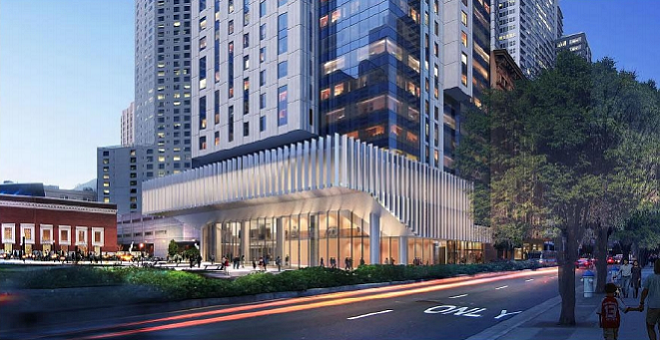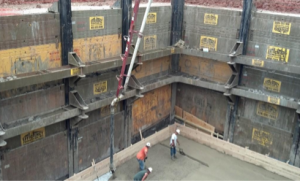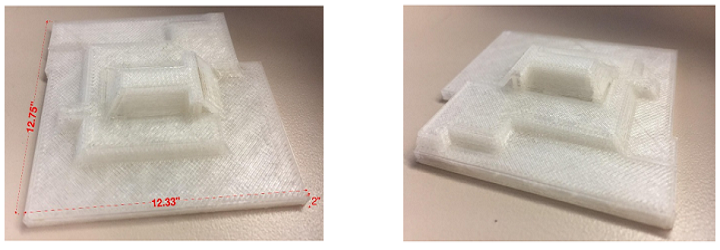Benjamin Jodis, a researchers at California Polytechnic State University, recently wrote a case study, titled “Analyzing the benefits of using 3D printing on the Mexican Museum renovation project in San Francisco, California,” about a specific use case of 3D printing in the construction industry. 3D printing is a good fit for construction, as it can take a detailed virtual rendering of a structure and produce an accurate physical model of it.
However, usage is not yet widespread in construction. This could be due to several different reasons, such as tight budgets inhibiting experimentation or a resistance to change.
The abstract of the case study reads, “The use of three-dimensional (3D) printing is not yet prevalent throughout the construction industry. Although there have been some uses, each has been small and relatively experimental, however, a current renovation project to the Mexican Museum in downtown San Francisco utilized 3D printing to aid in design coordination.”
Webcor Builders, the general contractor for the Mexican Museum project, realized that there could be a possible issue when pouring a section of the foundation. Two nine-foot vertical concrete walls surrounding the elevator shaft could threaten the project’s budget and schedule, with potential issues involving constructability, shoring, and waterproofing.
A general contractor on a commercial construction project will take away, on average, anywhere from 3-5% profit on a job. Webcor Builders, with a budget of $500 million on the museum project, could make anywhere from $15-25 million if everything goes well. But all sorts of things can cause projects to take longer than originally scheduled, such as decrease in production, liquidated damages, back charges, slow processing of documents, owner change orders, and, in this case, concrete walls.
“The aim of this case study was to analyze how the utilization of a 3D printed model benefitted the overall cost and schedule of the Mexican Museum project,” Jodis wrote. “In order to do this, qualitative research was conducted through several interviews with industry professionals closely related to this project. Initial interviews were conducted with an individual directly responsible for the implementation of this 3D model on the project.”
Jodis looked at how 3D printing was used during the project to help with the design process, how beneficial the 3D printed model was, and possible expansions on the use of the technology.
“The decision to utilize a 3D printed model is not standard procedure when faced with design constraints,” Jodis wrote. “However, the implementation of the 3D model proved to be beneficial on multiple fronts and opened the door to more innovation surrounding 3D printing within the construction industry.”
Jodis also conducted interviews with other industry professionals not connected to the museum project to determine what potential 3D printing has in construction, how it could adapt to be used more in the industry, and the biggest drawback of using the technology.
“Originally constructed in 1975, the main building of the museum will undergo a massive transformation, including seismic retrofitting, improved safety measures, and an aesthetic overhaul,” Jodis wrote about the Mexican Museum. “Additionally, a forty-five-story mixed-use residential tower will be erected adjacent the existing museum. When designing the foundation for the new tower, it was discovered that a pair of nine-foot vertical walls would be needed around the base of the elevator shaft.”
 These two walls would be a major issue, because of their geometry, the condition of the soil, waterproofing around the sharp corners of the walls, and the depth of excavation required. After multiple meetings, in which the design teams used 3D BIM models to help with visualization, Webcor Builders and the other contractors decided to have Shapeways 3D print a 12.75” x 12.33” x 2” plastic model of the base of slab excavation, in order to “alleviate some communication and design hurdles the contractor was anticipating.”
These two walls would be a major issue, because of their geometry, the condition of the soil, waterproofing around the sharp corners of the walls, and the depth of excavation required. After multiple meetings, in which the design teams used 3D BIM models to help with visualization, Webcor Builders and the other contractors decided to have Shapeways 3D print a 12.75” x 12.33” x 2” plastic model of the base of slab excavation, in order to “alleviate some communication and design hurdles the contractor was anticipating.”
“Chris Kiteas, a Project Engineer for Webcor Builders, was responsible for the concrete scope of the project and the direct correspondent with the design teams during these coordination efforts. He noticed that the biggest thing people were still getting caught up on was simply being able to clearly visualize the model,” Jodis explained in the case study. “During a monthly staff meeting, Chris proposed the idea of having the base foundation slab 3D printed to aid in the design and coordination of this slab, and shortly after he began researching companies capable of printing something like this in a timely manner.”
The 3D printed model gave everyone a better way to describe their own design constraints, and after just one meeting, all visualization concerns were gone.
“The ability for designers to make quick mock-ups of their proposed solutions to test and then refine, all within a single meeting cut out a lot of time waiting on email responses from one party or another,” Jodis explained. “The presence of the physical model during these coordination meetings drastically improved the productivity of the design team and allowed them to reach a resolution much faster than this problem would have likely taken had the initial approaches stayed constant.”
Using the 3D printed model, the Mexican Museum team found a way to work around the two walls.
While the 3D BIM model and the physical 3D printed model were only used for a small portion of the overall structure, and a non-permanent one at that, they helped avoid a larger design setback. The idea of using a physical representation, rather than only virtual renderings, can also highlight further 3D printing possibilities in the construction industry, such as concrete as a 3D printing material, helping speed up the Request for Information and submittal processes for projects, making scale models, and manufacturing custom tools.
Discuss this story and other 3D printing topics at 3DPrintBoard.com or share your thoughts below.
Subscribe to Our Email Newsletter
Stay up-to-date on all the latest news from the 3D printing industry and receive information and offers from third party vendors.
You May Also Like
Precision at the Microscale: UK Researchers Advance Medical Devices with BMF’s 3D Printing Tech
University of Nottingham researchers are using Boston Micro Fabrication‘s (BMF) 3D printing technology to develop medical devices that improve compatibility with human tissue. Funded by a UK grant, this project...
GaeaStar and Verve Coffee Roasters Start Pilot Production of Sustainable 3D Printed Coffee Cups
Following a 2022 debut in Germany, GaeaStar, a startup based in San Francisco and Berlin, has begun US pilot production of its sustainable, disposable clay cups and bowls made with...
Meltio and Accufacture Unveil Robotic Metal 3D Printer Made in the US
Meltio has partnered with Michigan-based robotics firm Accufacture to introduce Alchemist 1, a robotic cell designed for wire-laser metal 3D printing made in the US. This new system represents a...
WASP Highlights Advances in Healthcare 3D Printing at Italy’s Exposanità 2024
WASP takes center stage at Italy’s leading healthcare expo, Exposanità 2024, demonstrating the transformative impact of its advanced 3D printing technologies on the medical sector. Known for its line of...




































